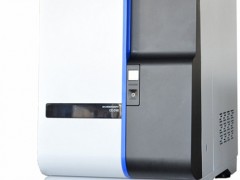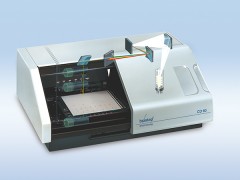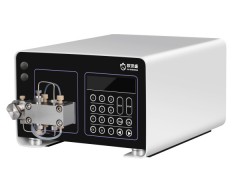TUNEL細胞凋亡檢測試劑盒
TUNEL細胞凋亡檢測試劑盒品牌:上海銘博 | 貨號:T2190
英文名稱 : TUNEL Apoptosis Assay KitCat.: T2190TUNEL Apoptosis Assay Kit
Size:50T
Kit Components:
Components Amount
Component A: 100X TF3-dUTP 1 vial (25 uL)
Component B: Reaction Buffer 1 bottle (5 mL)
Component C: 1000X Hoechst 1 vial (50 uL)
Introduction:
DNA fragmentation represents a characteristic of late stage apoptosis. DNA fragmentation in apoptotic
cells can be detected by terminal deoxynucleotidyl transferase (TdT)-mediated dUTP nick end labeling
(TUNEL). The TUNEL assay relies on the presence of nicks in the DNA which can be identified by TdT,
an enzyme that catalyzes the addition of dUTPs that are secondarily labeled with a marker. All the existing
TUNEL assays contain the highly toxic sodium cacodylate which might induces apoptosis and also
decrease DNA production and DNA strands. Our TUNEL Apoptosis Assay Kit uses proprietary buffer
system free of sodium cacodylate. The kit is based on incorporation of a fluorescence dye TF3 modified
deoxyuridine 5 -triphosphates (TF3-dUTP) at the 3 OH ends of the DNA fragments that form during
apoptosis. The assay is optimized for the direct detection of apoptosis in either detached or attached cells
without using antibody.
The kit provides all the essential components with an optimized assay protocol. It is suitable for
fluorescence microplate reader, fluorescence microscope, or flow cytometer. Its signal can be easily
detected at Ex/Em = 550nm/590 nm.
Assay Protocol:
1. Culture cells to an optimal density for apoptosis induction according to your specific protocol. We
recommend about 30,000 to 50,000 cells/well for adherent cells grown in a 96-well microplate culture, or
about 1 to 2 x 106 cells/mL for non-adherent cells. At the same time, culture a non-induced negative
control cell population at the same density as the induced population for every labeling condition. Here are
a few examples for inducing apoptosis in suspension culture:
1) Treat Jurkat cells with 2 g/ml camptothecin for 3 hours.
2) Treat Jurkat cells with 1 M staurosporine for 3 hours.
3) Treat HL-60 cells with 4 g/ml camptothecin for 4 hours.
4) Treat HL-60 cells with 1 M staurosporine for 4 hours.
2. Fixation and Permeabilization
2.1 Remove cell media.
2.2 Add 100 L/well/96-well plate of 4% formaldehyde fixative buffer (not supplied) to each well.
Note: For non-adherent cells, add desired amount (such as 2 x 106 cells/mL) of 4% formaldehyde fixative buffer.
2.3 Incubate plates for 20 to 30 minutes at room temperature.
2.4 Remove fixative.
Optional: add 100 L/well/96-well plate of the permeabilization reagent (0.2% Triton X-100 in PBS, not
supplied) after the fixation if needed, and incubate the plate for 10 minutes at room temperature.
2.5 Wash the cells with PBS 2-3 times.
Optional: You may also prepare a positive control for TUNEL reaction using DNAase I by digesting cells
with DNAase I for 30 min at room temperature before proceed to TUNEL reaction (Step 3)
3. TUNEL reaction
3.1 Prepare reaction mixture just before use based on the number of samples to be assayed:
Reaction Components Volume Per Well
100X TF3-dUTP (Component A) 0.5 uL
Reaction Buffer (Component B) 50 uL
Total volume 50.5 uL
Note: Each cell line should be evaluated on an individual basis to determine the optimal cell density.
3.2 Add 50 uL of the reaction mixture (from Step 3.1) to each well or tube and incubate at 37℃ for 60
minutes.
3.3 Remove the reaction mixture, and wash the cells 3-5 times with 200 uL/well of PBS.
4. Monitor the fluorescence intensity by fluorescence microscope, flow cytometer, or fluorescence
microplate reader at Ex/Em = 550/590 nm.
5. Optional: Stain the nucleus with 1X Hoechst (Component C, Ex/Em = 350/460 nm) for image analysis.
Data Analysis:
1. 96-Well Fluorescence Plate Reader Sample data:
Figure 1. Apoptosis analysis in Hela cells using TUNEL Apoptosis Assay Kit. Hela cells at 30,000
cells/100 L/well were treated with 1 M staurosporine for 4 h (Red) while un-induced cells were used as a
control (Blue). Cells were incubated with reaction mixture for 1 hour at 37℃. The Fluorescence was
measured at Ex/Em = 550/590 nm (cut off at 570 nm) with a Flex Station microplate reader using bottom
read mode.
2. Fluorescence Microscope Sample data:
A. Control B. 2h C. 4h
Figure 2. The Fluorescence imagining indicated the increase in TUNEL reaction with the addition of 1 M
staurosporin for 2h (B) or 4h (C) compare to control (A) in Hela cells. Cells were incubated with reaction
mixture for 1 hour at 37℃. The Fluorescence intensity of the cells (30,000 cells/ 100 L per well) was
analyzed under a fluorescence microscope with a TRITC channel. DNA strand breaks are shown as more
intense fluorescent staining spots in cells treated with staurosporin.
References
1. Gavrieli.Y, Sherman Y., Ben-Sasson S.A. 1992. Identification of programmed cell death in situ via
specific labeling of nuclear DNA fragmentation.J Cell Biol. 119(3):493-501.
2. Huerta S., Goulet E.J., Huerta-Yepez S., Livingston E.H.,2007. Screening and detection of apoptosis.
J Surg Res. 139(1):143-56.
3. Webster K., ParishJ, Pandya M., Stern P.L., Clarke A.R., and Gaston K. 2000. The human
papillomavirus (HPV) 16 E2 protein induces apoptosis in the absence of other HPV proteins and via a
p53-dependent Pathway* J Biol Chem. 275(1): 87-94.
4. Whiteside G., Cougnon N., Hunt S.P., and Munglani R. 1998. An improved method for detection of
apoptosis in tissue sections and cell culture, using the TUNEL technique combined with Hoechst stain.
Brain Res Brain Res Protoc 2: 160 164.
關(guān)注本網(wǎng)官方微信 隨時閱讀專業(yè)資訊
 手機版|
手機版|

 二維碼|
二維碼|











